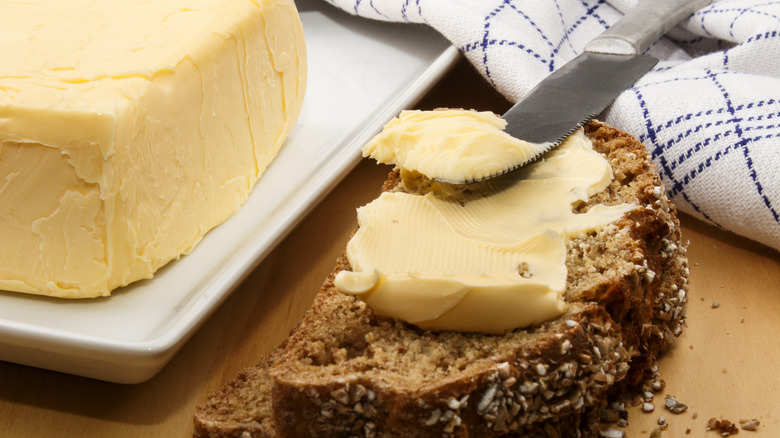Is It A Waste To Use Irish Butter For Cooking Or Baking?
The Danish word "tandsmør" literally translates as "tooth butter," meaning butter spread so thick you leave tooth marks after taking a bite. Some people believe the only way to truly appreciate the creamy texture and rich flavor of Irish butter, like the type offered by Kerrygold, is to reserve it solely as a spread. To them, using Irish butter in baking or cooking is akin to applying gold leaf to the exposed pipes under the kitchen sink; a too-elegant decor for something no one will ever see.
In all fairness, treating Irish butter like the best of the best is an understandable approach. Made from the milk of cows grazing in the ever-verdant pastures that the Emerald Isle is known for, Irish butter possesses a richer flavor and creamier texture than butter made with milk from hay or grain-fed cows. Additionally, beta carotene found in the green grasses those cows ingest gives the butter a bright, golden hue.
Like most European butters, Irish butter is higher in butterfat, 82% as opposed to 80% in the United States. It's also uncultured, which means it's made from fresh cream without the addition of any bacteria cultures or ferments to speed the churning process. Uncultured butter lacks an acidic tang, resulting in a rich, decadently creamy flavor, which when combined with its velvety texture makes it perfect for spreading on thick. So, should all this keep you from using it in your cooking or baking? The answer is complicated, but it mostly depends on whether your recipe needs high-fat, European-style butter or if butter is the star ingredient.
Irish butter in the cooking realm
At nearly $10 a pound, Irish butter is almost double the price of other, common U.S. brands. This inflated cost can cause a lot of cooks to be wary of reaching for it when looking to sauté veggies in a pat of butter. However, there is a time and place to incorporate butter into your cooking.
Think about dishes that rely on a very butter-rich sauce, like a simple bowl of buttered garlic noodles or a filet of fish that needs a coating of beurre blanc sauce. Irish butter wouldn't be a waste in these instances. Similarly, many cooked potato dishes, from a batch of Duchess potatoes to a creamy mash, absorbs every bit of the extra fat in the European-style butter, making it a welcome substitute.
Other than spreading Irish butter on your morning toast or chewy bagel, there's other good non-cooking uses for a condiment of this magnitude. Use it to make compound butter for an unforgettable bread and butter board, apply a thick slice to your next Wisconsin-style cheeseburger, or load it onto a hot baked potato. Because Irish butter is rich in vitamins and minerals, many cooks use it to make what they consider to be the ultimate ghee.
To bake or not to bake
While it's true that butters with a high percentage of butterfat can inhibit the rise in baking and make certain products greasier, this can also be attributed to the culture, or lack thereof, in Irish butter. According to the ICE (Institute of Culinary Education), the ferments added to cultured butter will help your batter or dough rise, so even if you're using a butter that's high in fat, the ferments will negate the dense texture. Typically, Irish butter lacks these ferments, so you should be wary of using it in baking recipes that haven't called for it, as it may make the overall product too heavy.
That being said, Irish butter, even though it is uncultured, is still a wondrous choice for butter-forward baked goods and savory dishes, especially where it's all-important to have an incredibly buttery flavor or flaky texture. Just think of recipes such as butter cookies, St. Louis Gooey Butter Cake, toffee, an all-butter pie crust, or browned butter chocolate chip cookies. Any baked good that needs to be laminated, like croissants or puff pastry, can benefit from this rich European-style butter. Irish butter is also an excellent choice for quick breads, where a dense, rich crumb outranks a high rise. Recipes such as sweet zucchini bread or pound cake are what high-fat Irish butter was made for.


